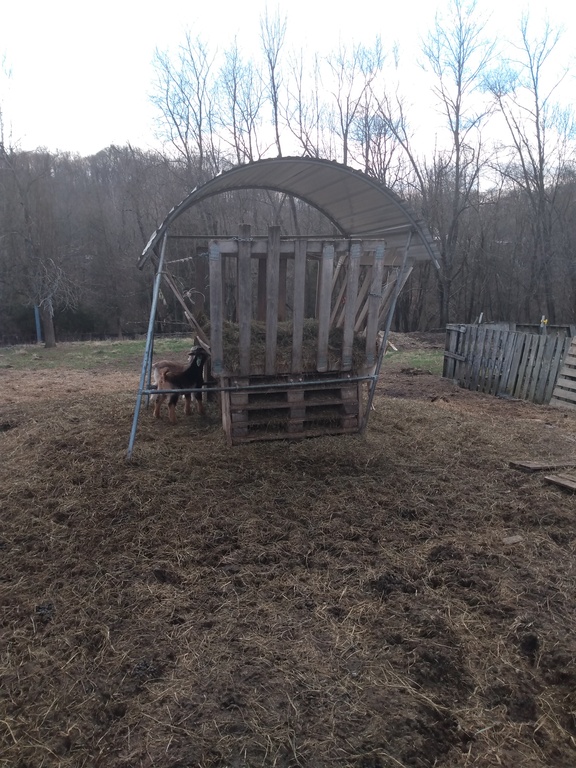





























Jay Green wrote:Actually, properly cultured and balanced deep litter will promote the growth and population of beneficial bugs and nematodes that prey on the parasite larvae




 1
1









Windward Sustainability Education and Research Center
Permaculture Apprenticeships at Windward
America's First Permaculture Cemetery? Herland Forest Natural Burial Cemetery








Lauren Dixon wrote:Hmm, interesting. Please tell me more about the korean method that you use. We also have rabbits, so I'd be interested in hearing more about how you keep them.
Ollie Puddlemaker
 2
2




Lauren Dixon wrote:I have my goat pens currently set up with portable corral panels. These work wonderfully! My question is about the sheer amount of waste these little critters produce.




A human being should be able to change a diaper, plan an invasion, butcher a hog, conn a ship, design a building, write a sonnet, balance accounts, build a wall, set a bone, comfort the dying, take orders, give orders, cooperate, act alone, solve equations, analyze a new problem, pitch manure, program a computer, cook a tasty meal, fight efficiently, die gallantly. Specialization is for insects.
-Robert A. Heinlein








Chris Kott wrote:Would it be a good or bad idea to do any of the following to maintain a deep litter culture?
1) allow chickens access periodically to pick out excess insect life
2) introduce Black Soldier Fly Larvae (they apparently love the non-carbon component of feces)
3) introduce red wigglers (vermiculture worms)
My reasoning is thus: chickens will clear out insect populations in the event of imbalance, and are run on pasture a few days after ruminants in some paddock shift systems; BSFL will assist in the rapid breakdown of all the litter, but focusing on the wet, brown nitrogen in the feces, and they would provide food for the chickens; and red wigglers will eat the rest of the litter, also potentially food for the chooks. I can anticipate the need to drop bedding more often, obviously, if this were implemented, but I think the soil coming out of the paddock would be far superior to the conventional deep litter. But would this defeat the purpose of deep litter, or is it good to speed the break-down of materials?
A laterally related question is whether or not bokashi is compatible with any of the previous measures.
-CK
Ollie Puddlemaker








 2
2




 2
2




 We usually have 40 to 60 kids a year now. So we have two shelters in our winter pasture one is moveable on skids the other is a 3 sided pole building. I did take pictures and i hope you can see them okay. I may also include pictures of my goat feeders. I still use the deep liter method for the winter. The pig thing didn't work out. The pigs are in their area. I take the manure to the pigs now with my tractor. So I have two bale feeders now. They are outside standalone feeders, one of them is the original bale feeder I mentioned before but I added a roof. I put a roof on the second round bale feeder too. The bale sits on a pedestal of pallets that i get for free where I pick up the spent brewers grains that i feed to my goats, chickens, pigs, horses and steers. I build sides that are hinged on all for sides of the feeder although I probably only needed to hinge one side. The sides have slats that are about 5 to 6 inches a part vertically. It may not look like it but each pedestal is 5 to six pallets tall. The goats drop that much hay around them. I still manage to bed dropped hay in the shelters and throw some in the pigpen which is alongside the winter goat pasture. I have chickens running in there too. I learned the hard way to put the slats vertically instead of horizontal. The round bale catches on horizontal slats and falls out the vertical slats let the hay fall over and down when I have to push it over with the pitchfork as the goats eat the sides. i push the top off in about 4 inch sections and let it slide down the side of the slats. I peel the bad stuff off the bale before I put it in the bale feeder. The goats can work their way through the bad stuff like horses and cows can. I peel the bales inside the three sided pole shelter and use it for bedding. The goats love it. They eat as much of it as they can before they poo and pee all over it. I am still using rotational grazing when things are growing. Works great and still have topped out on the amount of goats we can graze. Skiddable shelters in each pasture so the manure is not building up in one spot. Horses and cows follow the goats to help reduce parasites.
We usually have 40 to 60 kids a year now. So we have two shelters in our winter pasture one is moveable on skids the other is a 3 sided pole building. I did take pictures and i hope you can see them okay. I may also include pictures of my goat feeders. I still use the deep liter method for the winter. The pig thing didn't work out. The pigs are in their area. I take the manure to the pigs now with my tractor. So I have two bale feeders now. They are outside standalone feeders, one of them is the original bale feeder I mentioned before but I added a roof. I put a roof on the second round bale feeder too. The bale sits on a pedestal of pallets that i get for free where I pick up the spent brewers grains that i feed to my goats, chickens, pigs, horses and steers. I build sides that are hinged on all for sides of the feeder although I probably only needed to hinge one side. The sides have slats that are about 5 to 6 inches a part vertically. It may not look like it but each pedestal is 5 to six pallets tall. The goats drop that much hay around them. I still manage to bed dropped hay in the shelters and throw some in the pigpen which is alongside the winter goat pasture. I have chickens running in there too. I learned the hard way to put the slats vertically instead of horizontal. The round bale catches on horizontal slats and falls out the vertical slats let the hay fall over and down when I have to push it over with the pitchfork as the goats eat the sides. i push the top off in about 4 inch sections and let it slide down the side of the slats. I peel the bad stuff off the bale before I put it in the bale feeder. The goats can work their way through the bad stuff like horses and cows can. I peel the bales inside the three sided pole shelter and use it for bedding. The goats love it. They eat as much of it as they can before they poo and pee all over it. I am still using rotational grazing when things are growing. Works great and still have topped out on the amount of goats we can graze. Skiddable shelters in each pasture so the manure is not building up in one spot. Horses and cows follow the goats to help reduce parasites.

![Filename: balefeeder3.resized.jpg
Description: [Thumbnail for balefeeder3.resized.jpg]](/t/19131/a/172674/balefeeder3.resized.jpg)
![Filename: balefeeder5.resized.jpg
Description: [Thumbnail for balefeeder5.resized.jpg]](/t/19131/a/172676/balefeeder5.resized.jpg)
![Filename: gaotfeeder2.resized.jpg
Description: [Thumbnail for gaotfeeder2.resized.jpg]](/t/19131/a/172677/gaotfeeder2.resized.jpg)
![Filename: goatfeeder3.resized.jpg
Description: [Thumbnail for goatfeeder3.resized.jpg]](/t/19131/a/172678/goatfeeder3.resized.jpg)
![Filename: goatfeeder4.resized.jpg
Description: [Thumbnail for goatfeeder4.resized.jpg]](/t/19131/a/172679/goatfeeder4.resized.jpg)




 2
2




Best luck: satisfaction
Greatest curse, greed
 2
2




You are what you eat.








Best luck: satisfaction
Greatest curse, greed

|
My sister got engaged to a hamster. This tiny ad is being too helpful:
Established homestead property 4 sale east of Austin TX
https://permies.com/t/259023/Established-homestead-property-sale-east
|






